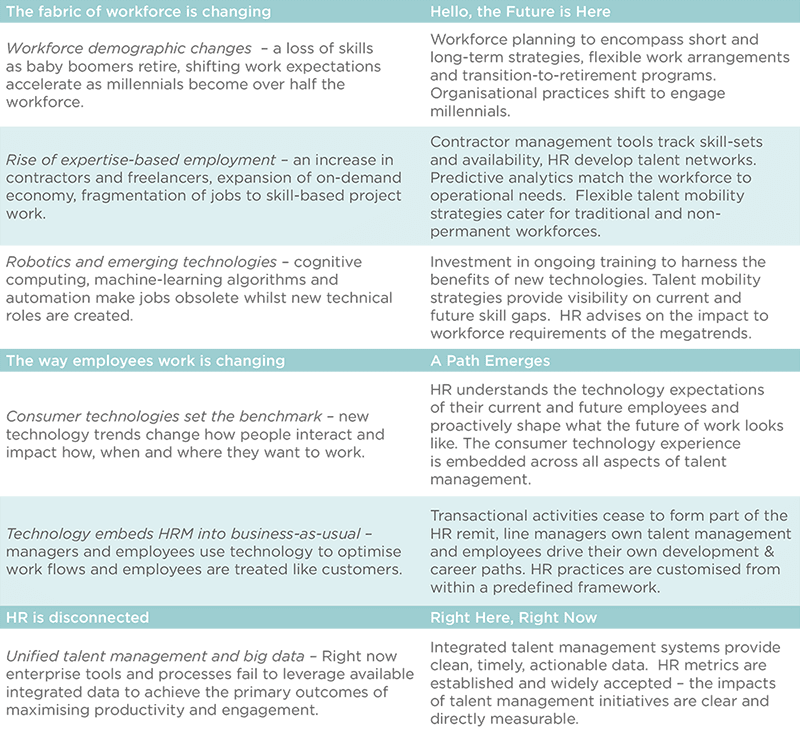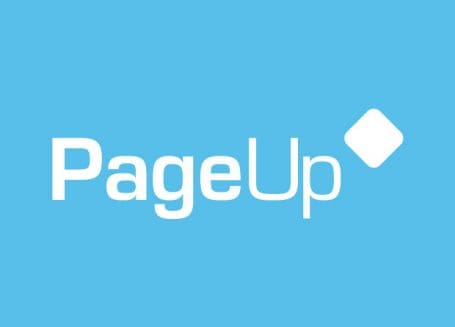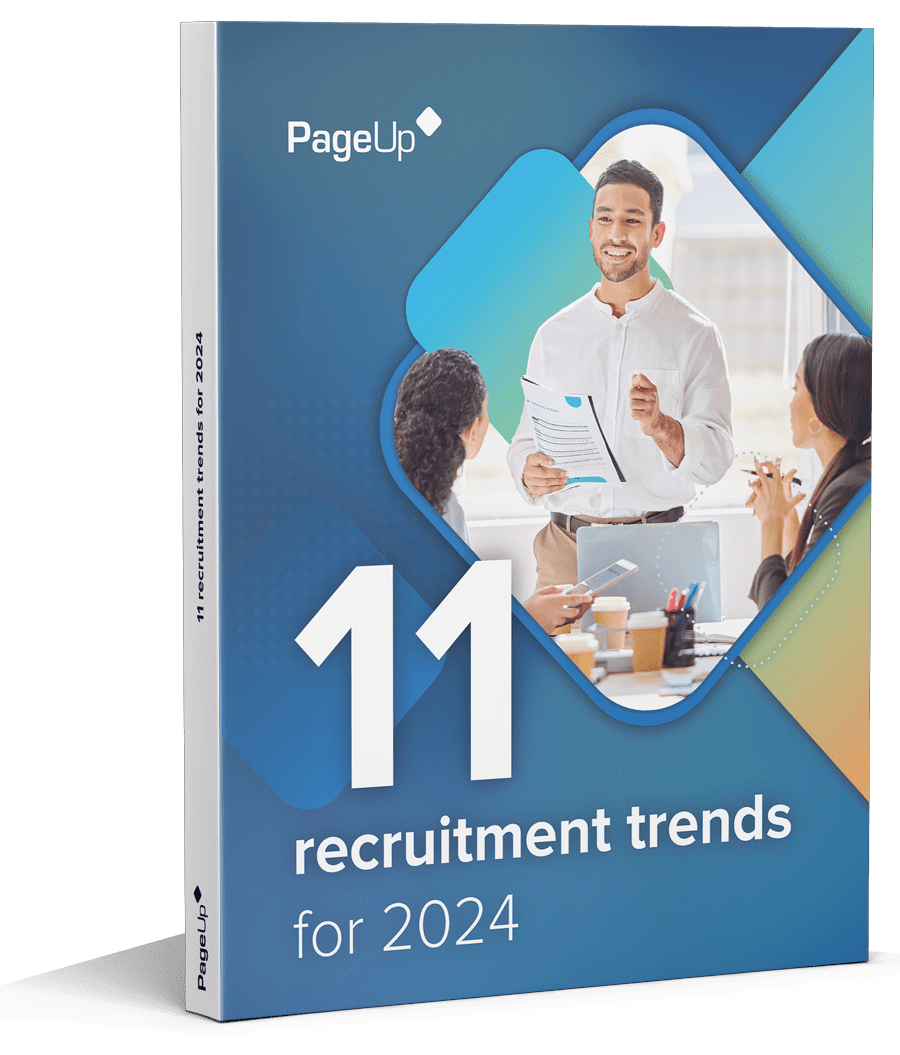Executive Summary
Disruptive technologies, changing demographics, contractors and freelancers are altering the fabric of the workforce. Social, mobile and cloud connectivity are transforming how, where and when people work and the consumer experience is reshaping workplace expectations.
The pressure on HR to deliver strategic value continues to intensify with both business and HR leaders rethinking its role. HR needs business acumen and strategic focus to unleash the potential of organisationalorganizational talent and create a compelling value proposition.
HR in its current form is unlikely to continue. We expect to see a transformation wherein the HR models of today fragment and new designs emerge:
Extinction – Transactional HR and talent management are automated or outsourced. Sophisticated and engaging technology replaces HR and shifts talent management to the line manager and employees.
Metamorphosis – HR becomes a talent enabler focused on coaching and strategic decision making. HR centres on identifying and developing future leaders with the dual capability to engage people and drive strategic outcomes.
Evolution – A new breed of HR emerges to focus on analytics and workforce management. Strategic business decisions will be based on predictive modelling that includes talent data.

The future is uncertain but the need to plan is not
Paint a Picture of the Future
- Disruptive technology
- Global economic realignment
- Diminishing resources
- Unskilled labour surpluses
- Skilled labour deficits
- Multiple generations
Monumental forces are altering the future of work. Digital technology is shaping and reshaping the workforce. It is influencing how, where and when people work. Emerging technologies, including advances in robotic process automation and artificial intelligence are redefining jobs and in some cases, making people obsolete.
Baby boomers are retiring, taking their knowledge and experience with them and creating skill shortages in many industries. Meanwhile, millennials are entering the workforce en masse with expectations that are heralding a new era of work. Already, 40% of people believe that traditional employment models will cease to exist and instead individuals will manage their own personal brand and sell their skills in an open market(1).
To survive, organisationsorganizations are reshaping their understanding of how these forces are impacting their markets and their workforce needs. Yet a fundamental misalignment exists between what companies need to do to thrive in the future and their immediate corporate drivers. Short-term profitability and shareholder returns drive business behaviour and discourage thinking beyond the next financial year, let alone the next decade. Clear vision and a strong strategy will ensure companies can attract and retain the workforce they need to execute on business objectives.
Set against this backdrop, Human Resources faces its own crisis. Less than one quarter of HR professionals are actively factoring the evolving and volatile landscape of the future into their long-term business planning(1). Many Chief Human Resource Officers (CHROs) are focused on optimising employee engagement and building corporate culture, but continue to struggle to link HR to real business needs.
Although most organisationsorganizations claim they want data-driven, strategic HR outcomes, 70% are yet to take positive steps to help HR achieve this
HR critics accuse the function of lacking the skills to analyse why individuals or departments are not meeting strategic organisationalorganizational goals. After decades of discussion about the need for “a seat at the table”, 38% of executives still believe HR should focus on its traditional role of managing benefits, compensation and compliance(2). Often HR is not viewed as a strategic function and although most organisationsorganizations claim they want data-driven, strategic HR outcomes, 70% are yet to take positive steps to help HR achieve this(2).
Too often HR is branded a support function, existing to support strategy rather than to help shape it. The contraction of HR departments over the last few years has left many HR departments under-resourced. When there are not enough hours in the day to deliver both strategic and transactional objectives, the transactional always take priority.
Technological advances have enabled the automation of many transactional elements, creating economies of scale and cost savings. Employee and manager self-service have improved engagement and productivity. The embedding of some aspects of HR into the business through the splitting of transactional and strategic functionality should theoretically free up time to allow HR to focus on strategic initiatives.
However without the required skill set, business acumen and support of senior stakeholders, HR professionals struggle to deliver workforce strategy aligned to the business needs. HR suffers from poor public relations and branding and is rarely perceived as a career destination for those who really want to make a difference in business.
As emerging technologies, digital advances and changing demographics alter the workforce of the future, the pressure placed on HR to deliver strategic value will intensify. Merely ‘remaining relevant’ under-rates the potential of HR. Yet to take a leadership stand, a fundamental shift in HR is required. New skills for the digital era includes Immersion in the business, Strategic vision, influence and advisory capacity.
New skills for the digital era includes:
- Immersion in the business,
- Strategic vision,
- Influence and advisory capacity.

Hello, the Future is Here
- Workforce demographic changes
- Freelancers, contract labour and remote workers
- Robotics and advanced technologies
The composition of the workforce is changing. Traditional career models are transforming; some jobs will become obsolete and others will change beyond recognition. In a Volatile, Uncertain, Complex, Ambiguous (VUCA) world, only a few business leaders are fully ready and able to deal with a technology-led workplace transformation. Adding to the complexity is the changing makeup of the workforce – baby boomers are exiting, millennials have come of age and are demanding flexibility, meaning and high-touch engagement. The on-demand economy is on the rise and traditional work models are fragmenting with an influx of freelancers, contractors and virtual workers. In some industries, advances in technology will simply make human labour unnecessary or uneconomical.
The future is uncertain, but the necessity of acknowledging, understanding and proactively preparing for it is not. As technology continues to transform the global economy, business leaders must look ahead and plan. Here we identify three themes shaping the workforce of the future:
- Workforce demographics changes – surpluses and deficits
- Rise of expertiseexpertize-based employment – freelancers, contractors, virtual workers
- Robots and emerging technologies – jobs impacted by digitisation.
Is this the beginning of the end of work as we know it?
Is our ability to understand and measure the changing nature of work lagging behind the reality of the new order?
DOWNLOAD THE FULL WHITEPAPER!
If you like this content, you’ll love our Talent Lab, part of PageUp’s Global Research initiative and a go-to destination for HR thought-leaders to push the boundaries and challenge the status quo.
Fresh insights for HR
Stay up to date with HR trends, tips and more when you sign up for our industry newsletter





